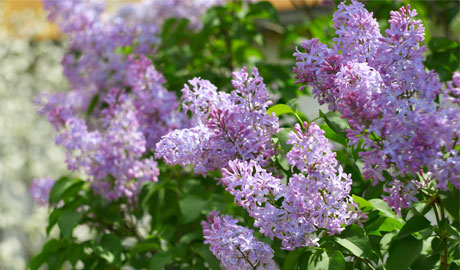Lilacs

For heady fragrance, masses of blooms and ease of care, these old-fashioned favorites have it all. Lilacs steal the show in spring, they provide an interesting backdrop for summer-blooming perennials and shrubs. Lilacs are not difficult to grow, but they do have a few basic requirements.
Requirements
To bloom well, lilacs need full sun. Lilacs may be able to survive in shade, but they will disappoint you come spring. Lilacs do best with a neutral to alkaline soil pH. Lime can be added to acidic soils to raise the pH. It is also important to plant lilacs in a well drained spot. Heavy clay soils should be amended with perlite to provide better drainage. Lilacs respond best to transplanting in early spring, before they leaf out, or in early fall, after they go dormant.
Spacing
When planting lilacs be sure to give them enough space. Overcrowding is the most common error gardeners make with lilacs. For most varieties, planting them at 6-10’ intervals will allow them ample room to grow.
Fertilizing
Once planted, lilacs may take several years to bloom, even though it may have been blooming when purchased. Those flowers were formed the summer before bloom, and winter over in plump terminal buds. Allow your lilac a few seasons to become established. Fertilizing isn’t usually necessary for established plants, but if you feel the need, fertilize in early spring with 5-10-10.
Pruning & Maintenance
Lilacs are prone to a gray-white leaf residue called powdery mildew. It may look bad, but it doesn’t do permanent damage. Provide good air circulation by allowing proper spacing. Also pruning provides better air circulation, encourages more blooms and better shaped shrubs. Because lilacs bloom on old wood, prune in early summer after the blooms have faded, but before new buds are formed. When pruning, start with the three D’s – remove any wood that is dead, damaged, or diseased. Every year or two, cut out several suckers from the base of the plant and also prune back wayward branches to maintain an attractive shape and size. Deadheading spent blooms is not necessary, unless the blooms become unsightly.
